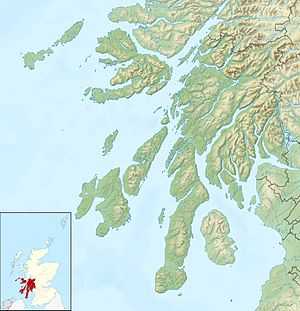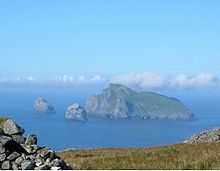Easdale
| Location | |
|---|---|
 Easdale Easdale shown within Argyll and Bute | |
| OS grid reference | NM735172 |
| Coordinates | 56°17′32″N 5°39′29″W / 56.29222°N 5.65806°WCoordinates: 56°17′32″N 5°39′29″W / 56.29222°N 5.65806°W |
| Names | |
| Gaelic name | Eilean Èisdeal |
| Meaning of name | Uncertain |
| Physical geography | |
| Island group | Slate Islands |
| Area | 25 hectares (62 acres)[1] |
| Highest elevation | 38 metres (125 ft) |
| Political geography | |
| Sovereign state | United Kingdom |
| Country | Scotland |
| Council area | Argyll and Bute |
| Demographics | |
| Population |
59 [2] |
| Population rank | 53 [3] |
| Population density | 295 people/km2[2][4] |
| References | [5] |
Easdale (Scottish Gaelic: Eilean Èisdeal) is one of the Slate Islands, in the Firth of Lorn, Scotland. Once the centre of the Scottish slate industry, there has been some recent island regeneration.
A ferry sails from Easdale to Ellenabeich (Gaelic: Eilean nam Beathach) on the nearby island of Seil (Gaelic: Saoil), which is separated from Easdale by only a narrow channel. Confusingly, Ellenabeich is sometimes known as Easdale as a result of its traditional connections with the island.
Etymology
In 1549, Donald Monro, Dean of the Isles wrote, in brief reference to Easdale, of an island "namit in the Erische Leid Ellan Eisdcalfe"[6][7] However the derivation of "Eisdcalfe" and this word's etymological relationship to "Easdale" is not clear. Haswell Smith (2004) notes that eas is Gaelic for "waterfall" and dal is Norse for "valley".[4] Nonetheless, it is not clear why either description should apply to the island which is low lying and has no waterfalls.
The Gaelic name, Èisdeal ([ˈeːʃtʲəl̪ˠ]) or Eilean Èisdeal has a long vowel and local folk legend attributes this to a derivation from èist thall "listen to that yonder".[8] Gaelic Place-Names of Scotland states that the first element is obscure, the second Norse dalr.[9] It is not clear if this Èisdeal shares its derivation with Gleann Èisdeal (Glen Ashdale) (Glen of Ash trees)[10] on the Isle of Arran.
Ellenbeich is usually analysed as Eilean nam Beathach ([ˈelan əm ˈpɛhəx]) "island of the animals" but this may be a reflex of an earlier and homophonous form Eilean nam Beitheach "island of the birch trees".[10]
History
Once a centre of the British slate industry, Easdale had a community of more than 500 working as many as seven quarries, some of which extended to 300 feet below sea level. Easdale slate helped to build major cities of the British Empire and can still be seen on rooftops as far afield as Melbourne, Nova Scotia, Dunedin and Dublin. The last slate was cut in the 1950s and the once active quarries are little more than still pools which provide a safe haven for a wide variety of flora and bird life.[11]
Nearby the former island Eilean-a-beithich once stood in the Easdale Sound between Easdale and Seil; however, it was quarried to a depth of 76 metres (249 ft) below sea level leaving only the outer rim of the island. This was eventually swept away by the sea and little visible sign of the island now remains.[12]
By the early 1960s, the population had dwindled to only four people and the island appeared doomed. Descendants of the original quarrymen, along with others from around the world, have moved to Easdale to create a model of island regeneration. The island now has a population of around sixty people and is the smallest permanently inhabited island of the Inner Hebrides.[13][14]
Current ownership
The island is owned by Jonathan Feigenbaum, who succeeded his late father Clive Feigenbaum (the former chairman of Stanley Gibbons). Clive created local issues of stamps, and Jonathan has continued doing this.[4][15]
Facilities and activities
The island is home to a folk museum owned and operated by the Eilean Eisdeal, a development trust, as well as a bar/restaurant called "The Puffer".[16][17][18] Eilean Eisdeal spearheaded the renovation of the Easdale Island Community Hall, which provides a venue for a wide variety of events.[19] According to Mike Scott of The Waterboys: "The Hall itself is magical. From the first sighting of its pyramid roof and arced frontispiece across the water to stepping off its stage at the end of the concert, it cast a spell on us."[20]

In 2005 the local authority, Argyll and Bute Council, discussed plans to build a bridge between the island and Seil, linking the island to the mainland by road,[21] despite there being no roads on Easdale. A company who operate high speed boat trips to view wild life and other local places of interest in the area have their base on Easdale.[22]
The World Stone Skimming Championship[23] has taken place annually in September on Easdale since 1997. In 2012 the event came under threat after Jonathan Feigenbaum requested £1,000 for using the slate quarry the championship uses. The competition only went ahead after the Press and Journal newspaper offered to pay the fee.[24] A community buyout of the island by residents is now under consideration. Mike Russell, MSP for Argyll and Bute said: "Not every community will achieve it and not every community should achieve it. But it is a live issue and becomes even more live in circumstances such as these."[25]
Images of the island
-

The decaying pier of Easdale quarry which was used to load the slate from the nearby quarries
-

Easdale ferry terminal
-

A sea filled former quarry facing Ellenabeich
Footnotes
- ↑ Rick Livingstone’s Tables of the Islands of Scotland (pdf) Argyll Yacht Charters. Retrieved 12 Dec 2011.
- ↑ 2.0 2.1 National Records of Scotland (15 August 2013) (pdf) Statistical Bulletin: 2011 Census: First Results on Population and Household Estimates for Scotland - Release 1C (Part Two). "Appendix 2: Population and households on Scotland’s inhabited islands". Retrieved 17 August 2013.
- ↑ Area and population ranks: there are c. 300 islands >20ha in extent and 93 permanently inhabited islands were listed in the 2011 census.
- ↑ 4.0 4.1 4.2 Haswell Smith (2004) p. 78
- ↑ Ordnance Survey. Get-a-map (Map). 1:25,000. Leisure. Ordinance Survey. Retrieved 21 August 2013.
- ↑ Monro (1549) "Eisdcalfe" No. 36. Translation from Scots: "named in the Gaelic language Eilean Eisdcalfe".
- ↑ Gillies (1909) p. 154
- ↑ "How Easdale got its name.". Tobar an Dualchais. Retrieved 26 May 2011.
- ↑ "Easdale". Gaelic Place-Names of Scotland. Retrieved 26 May 2011.
- ↑ 10.0 10.1 Mac an Tàilleir, Iain (2003) Ainmean-àite/Placenames. (pdf) Pàrlamaid na h-Alba. Retrieved 26 August 2012.
- ↑ "Community website". The Easdale Island Trust. Retrieved 2007-07-28.
- ↑ "Slate Islands - The Islands that Roofed the World" southernhebrides.com. Retrieved 14 November 2009.
- ↑ This is true only if bridged and tidal islands are excluded. Eilean Bàn, which is part of the Skye Bridge and Eilean Donan, which is tidal, were both inhabited at the time of the 2001 Census and smaller.
- ↑ General Register Office for Scotland (28 Nov 2003) Occasional Paper No 10: Statistics for Inhabited Islands
- ↑ "Modern British Local Posts CD Catalogue, 2009 Edition". Phillips. 2003. Retrieved 2008-12-08.
- ↑ "Eilean Eisdeal" easdale.org. Retrieved 14 May 2011.
- ↑ "The Puffer Bar and Tearoom" pufferbar.com. Retrieved 14 May 2011.
- ↑ "Eilean Eisdeal". Development Trusts Association Scotland. Retrieved 22 May 2011.
- ↑ "About Easdale: Easdale Island Community Hall". easdale.org. Retrieved 14 May 2011.
- ↑ "Home page: Stay Informed!..." easdaleislandhall.org. Retrieved 14 May 2011.
- ↑ Paul Kelbie (2005-05-23). "Storm brews over island idyll as council plans to build bridge". The Independent. Retrieved 2007-07-28.
- ↑ "Welcome to Seafari" Seafari. Retrieved 18 November 2009.
- ↑ "World Stone Skimming Championship". Retrieved 2007-07-28.
- ↑ "Easdale World Stone Skimming Championships saved by £1,000 donation". (20 September 2012). BBC News. Retrieved 25 September 2012.
- ↑ McKenzie, Steven "What motivates communities to buy land they live on?". (20 September 2012). BBC News. Retrieved 25 September 2012.
References
- Gillies, Patrick Hunter (1909) Netherlorn, Argyllshire, and its neighbourhood. Virtue.
- Haswell-Smith, Hamish (2004). The Scottish Islands. Edinburgh: Canongate. ISBN 978-1-84195-454-7.
- Monro, Sir Donald (1549) Description of the Western Isles of Scotland. William Auld. Edinburgh - 1774 edition.
External links
| Wikimedia Commons has media related to Easdale. |
| ||||||||||||
| ||||||||||||||||||||||||||||||||||||||||||||||||||||||||||||||||||||||||||||||||||||||||||||||||||||||||||||||||||||||||||||||||||||||||||||||||||||||||||||||||||||||||||||||||||||||||||||||||||||||||||||

